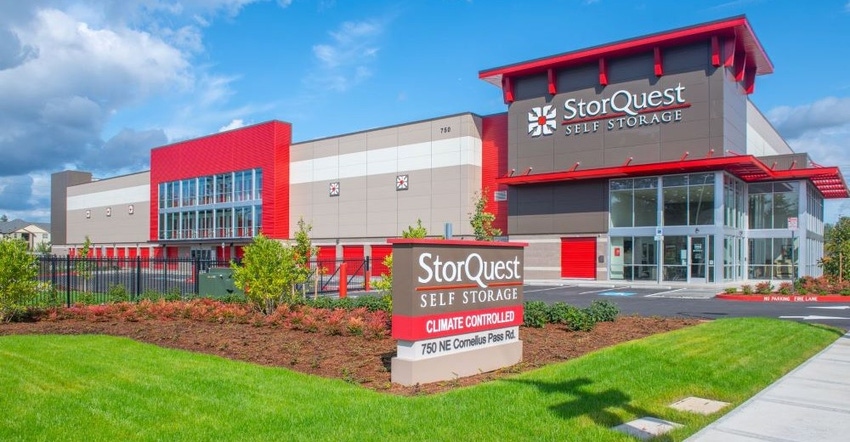Landscape Design and Maintenance for Your Self-Storage Site
If you think the landscaping at your self-storage facility doesn’t make an impact on customers, think again. It’s a critical part of your curb appeal! It can also have an impact on the local environment. Here’s some advice from a landscape architect on initial design and ongoing maintenance of trees, shrubs and other plantings.

Self-storage owners need to make choices around their facility landscaping at the time of construction, but it doesn’t end there. It’s an ongoing project that evolves over time. Even the most well-designed outdoor spaces need occasional renewal, so regular maintenance is necessary, too. All these decisions and tasks are important, as they affect curb appeal, local environment and more.
Vegetation comprised of trees, shrubs and groundcover has played a role in creating pleasant human settings since the paradise gardens were celebrated by early civilizations. It provides a sense of comfort and relief. In fact, the right choices make a great first impression on prospective self-storage tenants, setting the tone for their expectations. They convey that you care about customers’ well-being and the quality of your property. Would you prefer that your facility be perceived as welcoming, safe and comfortable, or unfriendly and forbidding? If you choose the former, the right landscaping can help.
What to Include
Typical landscaping for a self-storage business comprises trees, shrubs and flowers, which can vary based on location. Groundcover is also important, with turfgrass or mulch being commonly used in commercial applications. On the positive side, they infiltrate some rainfall, and are economical to maintain. They also don’t contribute to the urban heat-island effect. However, they’re less desirable from an ecological standpoint than a more horticulturally sophisticated treatment.
With the exception of turfgrass, most vegetative groundcovers require weeding by knowledgeable landscape workers. That said, turfgrass does come with the added expense or burden of mowing. Narrow strips of turfgrass between planting beds, sidewalks or curbs are undesirable and should be avoided. Another downside is it isn’t a suitable option in dry regions of the country, as it’s water-intensive.
Other planting-bed groundcover options are wood chips and gravel aggregates. Both will maintain the permeability of the surface. I don’t recommend artificial turf as a surface treatment. Though it may initially achieve a degree of permeability when installed over a penetrable base, it’ll likely clog over time.
When choosing any flora for your self-storage property, a key consideration is the need for water. Vegetation that requires irrigation can be costly to maintain and may be vulnerable to occasional water bans, depending on where your self-storage facility is located. Landscapes that incorporate the naturally occurring plants of the local region have become more popular and are a smart choice because they’re more likely to flourish on your property and don’t require excessive watering.
One quick note on landscape placement: If you create islands in parking lots or against the southern walls of buildings, they’ll be subject to much harsher than normal growing conditions, so choose your plant life for these locations wisely.
Landscape Maintenance
In terms of ongoing landscape maintenance, your initial design choices can significantly affect your long-term obligations. The requirement for watering is only one factor. Tree and shrub pruning is also important for the long-term care and health of your landscaping.
A skillfully pruned space conveys a sense of order and attention to detail. This being the case, many self-storage operators opt to outsource to a professional. When selecting a grounds-maintenance contractor, don’t assume they’re well-qualified to perform all necessary tasks. When soliciting proposals, request references and photographs of current projects.
If you’re in a northern region, be mindful of snow removal and the products you use for de-icing, as they can negatively impact your landscaping. Snow-plowing equipment can easily injure your plant beds. To help equipment operators identify and avoid them, it’s a good idea to use flexible plastic markers. Salts are harmful to plant materials, so it’s best to minimize their use.
Choose Wisely
Your self-storage landscaping is certain to evolve over the productive life of the property. Plant materials can be expected to grow to their intended size and beyond. A well-designed and -maintained landscape will complement your facility for many years, while poor choices and lack of maintenance can reflect poorly on the business and result in the need for full-scale replacement.
When designing your landscaping, consider the long-term maintenance implications. This’ll contribute to your best return on investment and minimize impact on downstream properties.
Charles Brenton is founder and design director of Baltimore-based Brenton Landscape Architecture, which provides a range of design services from natural resource inventory to finished construction drawings. Charles has designed landmark community open spaces, streetscape and conservation projects. For more information, call 443.682.9310.
About the Author(s)
You May Also Like





